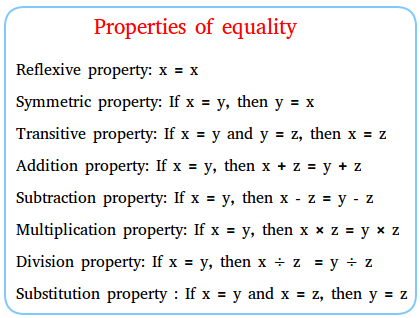Properties of equality
There are 8 properties of equality and their names are listed below. We will define them and when appropriate, we will illustrate with real life examples of properties of equality.
- Reflexive property
- Symmetric property
- Transitive property
- Addition property
- Subtraction property
- Multiplication property
- Division property
- Substitution property
Reflexive property of equality
Let x represent a real number.
The reflexive property states that a number is always equal to itself.
Mathematically, x = x
Examples:
2 = 2
-1020 = -1020
I am equal to myself
Symmetric property of equality
Let x and y represent real numbers.
If a number x is equal to another number y, then the number y is also equal to the number x.
Mathematically, if x = y, then y = x
Examples:
If x + 8 = -6, then -6 = x = 8
If fish = tuna, then tuna = fish
Transitive property of equality
Let x, y, and z represent real numbers.
If a number x is equal to another number y and the number y is equal to a number z, then the number x is also equal to the number z.
Mathematically, if x = y and y = z, then x = z
Examples:
If 2x + 8 = -12 and -12 = x - 2, then 2x + 8 = x - 2
If John's height = Mary's height and Mary's height = Peter's height, then John's height = Peter's height
Addition property of equality
Let x, y, and z represent real numbers.
The addition property of equality states that if the same quantity is added to both sides of an equation, then the left side of the equation is still equal to the right side of the equation.
Mathematically, if x = y, then x + z = y + z
Examples:
If 5 = 5, then 5 + 3 = 5 + 3
If x + -2 = 5, then x + -2 + 2 = 5 + 2
If John's height = Mary's height, then John's height + 2 = Mary's height + 2
Subtraction property of equality
Let x, y, and z represent real numbers.
The subtraction property states that if the same quantity is subtracted from both sides of an equation, then the left side of the equation is still equal to the right side of the equation.
Mathematically, if x = y, then x − z = y − z
Examples:
If 8 = 8, then 8 − 3 = 8 − 3
If 2y + 4 = 10, then 2y + 4 - 4 = 10 - 4
If John's height = Mary's height, then John's height − 5 = Mary's height − 5
Multiplication property of equality
Let x, y, and z represent real numbers.
The multiplication property states that if we multiply both sides of an equation by the same quantity, then the left side of the equation is still equal to the right side of the equation.
Mathematically, if x = y, then x × z = y × z
Examples:
Or suppose 10 = 10, then 10 × 10 = 10 × 10
Suppose Jetser's weight = Darline's weight, then Jetser's weight × 4 = Darline's weight × 4
Division property of equality
Let x, y, and z represent real numbers.
The division property states that if we divide both sides of an equation by the same quantity, then the left side of the equation is still equal to the right side of the equation.
Mathematically, if x = y, then x ÷ z = y ÷ z
Examples:
Suppose 20 = 20, then 20 ÷ 10 = 20 ÷ 10
Suppose Jetser's weight = Darline's weight, then Jetser's weight ÷ 4 = Darline's weight ÷ 4
Substitution property of equality
Let x and y represent real numbers.
If x = y, then y can be substituted for x in any expression.
Example:
x = 2 and x + 5 = 7, then 2 can be substituted in x + 5 = 7 to obtain 2 + 5 = 7
Here is a summary of the properties of equality
How to you use the properties of equality?
You can use the properties of equality to solve equations. For example, use the properties of equality to solve the linear equation below.
13x - 50 = 8x + 49
Subtract 8x from each side of the equation (subtraction property)
13x - 8x - 50 = 8x - 8x + 49
5x - 50 = 49
Add 50 to each side of the equation (addition property)
5x - 50 + 50 = 49 + 50
5x = 99
Divide each side of the equation by 5 (division property)
5x ÷ 5 = 99 ÷ 5
x = 19.8
Substitute 19.8 in 13x - 50 = 8x + 49 to check answer (substitution property)
13(19.8) - 50 = 8(19.8) + 49
257.4 - 50 = 158.4 + 49
207.4 = 207.4 (reflexive property)
Any questions about the properties of equality, let me know.
